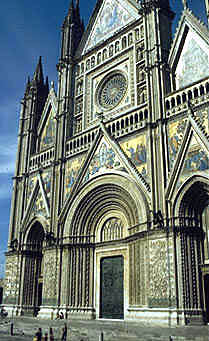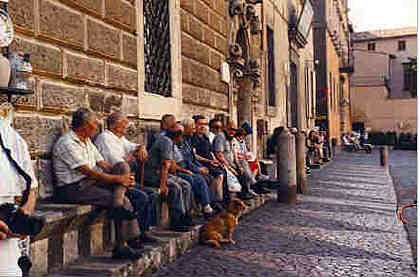| In the path of empire, the town has known a
turbulent past. It was dominated by its powerful neighbor to the south during Roman times
and was later occupied by barbarian invaders from the north. In the early twelfth
century, Orvieto became an independent city-state. Religious strife was added in the year
1281 when the French Pope Martin IV established his seat briefly in the town. Following
more civil and religious turmoil, the town was annexed to the papal state in 1354 and
finally to the new state of Italy in 1860.
Orvieto is close enough to Rome to be overlooked by the traveler who is awed by the
eternal city's attractions. But its proximity also means that it is easy to go there from
Rome by rail or road.
Motorists park in the Piazza Cahen near the edge of the escarpment. The walk up the Via
Postierla to the Piazza del Duomo is uphill, but not difficult. No matter how
cathedral-jaded the traveler might be, the first sight of the Orvieto Cathedral is
electrifying. There is no other like it.
The origins of the church are traced back to the journey of a Bohemian priest in 1263
to Rome. It seems that Peter of Prague had difficulty accepting  the transformation of the bread and wine into the body and blood of
Christ. He made a pilgrimage to the tomb of St. Peter to pray for faith. En route home,
while celebrating Mass at Bolsena, he witnessed blood dripping from the Host so copiously
that it soaked the altar cloth. Pope Urban IV, who happened to be in Orvieto, was so
profoundly moved when he learnedwhat had happened that he ordered that the cloth be
brought there for safekeeping. The event led to the Pope's establishing the Feast of
Corpus Christi for the entire Christian world and the construction of the cathedral to
house the relic. The foundation stone for the building was laid in 1290, but three
centuries passed before the work was finished. the transformation of the bread and wine into the body and blood of
Christ. He made a pilgrimage to the tomb of St. Peter to pray for faith. En route home,
while celebrating Mass at Bolsena, he witnessed blood dripping from the Host so copiously
that it soaked the altar cloth. Pope Urban IV, who happened to be in Orvieto, was so
profoundly moved when he learnedwhat had happened that he ordered that the cloth be
brought there for safekeeping. The event led to the Pope's establishing the Feast of
Corpus Christi for the entire Christian world and the construction of the cathedral to
house the relic. The foundation stone for the building was laid in 1290, but three
centuries passed before the work was finished.
Before going into the cathedral, sit for a moment on the stone bench against the shops
on the opposite

side of the piazza. Tour buses are not permitted in the square, and when I was last
there, private cars were prohibited from parking. (Would that city fathers of other towns
of historic and scenic interest all over Europe were so wise.) After the walk up the hill,
the respite is good both for body and spirit.
The facade of the church is a magnificent blending of mosaics, statuary, lacy
stonework, and the fourteenth-century Rose Window. At the base of the four pilasters are
delicate marble bas-reliefs of Biblical scenes. The interior is striking with typical
Italian horizontal stripes of white and green marble.
By the way, don't expect to see the famous relic during a casual visit to the
cathedral. It is shown to the public only twice each year, on Easter afternoon and on
Corpus Christi. One may see the reliquary, itself one of the most impressive works of art
in the cathedral, which holds the cloth.
Leaving the cathedral, walk westward through the narrow, winding streets-- be careful
of the low arches--stopping at shops along the way. Orvieto has been famous for its
pottery since the thirteenth century and lately has enjoyed a resurgence in ceramics as
artistic expression.
Find your way to the Piazza della Repubblica. On one side of the pretty little square
is the sixteenth-century Palazzo Comunale, the town hall. Adjacent is the Church of St.
Andrea. Reputedly established in the sixth century atop the ruins of an Etruscan temple,
the church served as a seat and meeting hall of Orvieto during its republican era. The
present building dates from the eleventh and twelfth centuries. Pope Innocent III
announced the Fourth Crusade here.
On leaving St. Andrea, turn right into the Corso Cavour, one of the most interesting
streets in the town, lined with shops and historic buildings. After walking about three
blocks, turn left to reach the Piazza del Popolo.
The piazza is dominated by the exquisite Romanesque-Gothic Palazzo del Capitano del
Popolo. Built of soft tufa stone in the mid-twelfth century as a papal palace, it was
later given to the republic to house the Captain of the People. The mullioned-triple
arched windows are particularly interesting. A colorful market is held in the piazza on
Thursday and Saturday mornings.
Return to the Corso Cavour now and stroll down the hill to the Piazza Cahen. Walk
across the piazza where you will see the ruins of an Etruscan temple and the Pozzo di San
Patrizio, St. Patrick's Well.
The well was built on the orders of Pope Clement VII in the early sixteenth century.
The pope had fled Rome during the sacking in 1527 and had established his residence in
Orvieto. The well was intended to provide fresh water if the hilltop town were besieged.
To reach the level of the water, one must descend one of two non- communicating staircases
about 205 feet. Built into the wall of the well, the staircases are illuminated by seventy
windows and are sufficiently wide and gradual for pack animals to make the descent.
As you leave Orvieto, take time to visit the Croce del Tufo, an Etruscan cemetery, on
the road toward the railway station. The tombs of this ancient "city of the
dead" range along a street in urban fashion. Occupants' names are carved in Etruscan
characters in the soft tufa stone. Recently-discovered materials from the tombs may be
seen at the Claudio Faina Archaeological Museum on the Piazza del Duomo, facing the
cathedral front.
It goes without saying that the best way to see Orvieto is to spend a night or two.
Most people visit the town during a quick stop between Rome and Venice or Florence. Stay
for the night, and the town is yours after the day-trippers leave. Stay here after your
visit to Rome, and you will enjoy it even more.
Caveat and disclaimer: This is a freelance travel article that I published some
time ago. Some data, especially prices and contact information, may not be current.
Write to the author.
Writing |
Home |
Travel Articles |